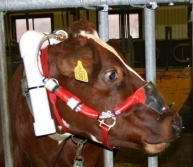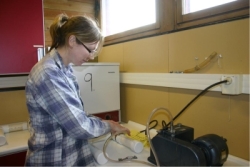Facts:
The project was financed by FORMAS and the Swedish Board of Agriculture.

We will study the effects of high-forage feeding in the period after the cows have come in calf on milk production, feed efficiency, milk quality and animal welfare compared with conventional feeding. Further there will be carried out determinations on enteric methane production. These results will be compared with those used in official statistics. The results from the trials will be used for economic evaluations and for modelling of environmental consequences of different feeding strategies. The experiments will also form the basis of a PhD thesis. Our aim is to compile data for a Swedish dairy production model, based on high proportions of forage, grass silage as well as pasture. For this purpose we intend to perform a long-term trial with high-producing dairy cows. The trial will comprise three experimental treatments and last for two years and comprise at least 80 whole lactations. Two of the treatments will be according to organic rules regarding roughage proportion in the diet. After that the proportion will be at least 60 % (group 1) or gradually increased to 90 % (group 2). As a control there will be one treatment (group 3), where the feeding will be according to conventional Swedish feeding standards; 40 % forage in early lactation and ca 50 % in later part of the lactation. The proportion will be held both when feeding grass silage in winter and during the grazing period.
The methane (CH4) emissions from the dairy cows are currently being measured at Kungsängen Research Station within the project “Sustainable dairy production based on high-forage diets”. The experiment runs from October 2008- Januari 2009 and consists of three trial periods. The aim is to compare the CH4 emissions from the three diets and also compare the results with theoretical calculations. Six rumen fistulated cows are fed the three different proportions of grass-silage described earlier. The CH4 is measured by the Sulfur hexafluoride (SF6) tracer technique. In this technique, a small permeation tube filled with a known release rate of SF6 is placed in the rumen. An evacuated canister is placed around the cow’s neck and connected to a halter fitted with a capillary tube. In this way a constant rate of air around the mouth and nose of the cow is collected. The canisters are changed every 24 hours and samples are taken for gas chromatography analyses. The CH4 emission rate is then calculated from the concentrations of CH4 and SF6 in the samples and the release rate of SF6.
Jan Bertilsson
Ewa Wredle, Eva Spörndly


Wanted: windy cows for diet trials (article in the Times)
Mikaelas doctoral thesis: Effects of increasing the proportion of high-quality grass silage in the diet of dairy cows
The project was financed by FORMAS and the Swedish Board of Agriculture.